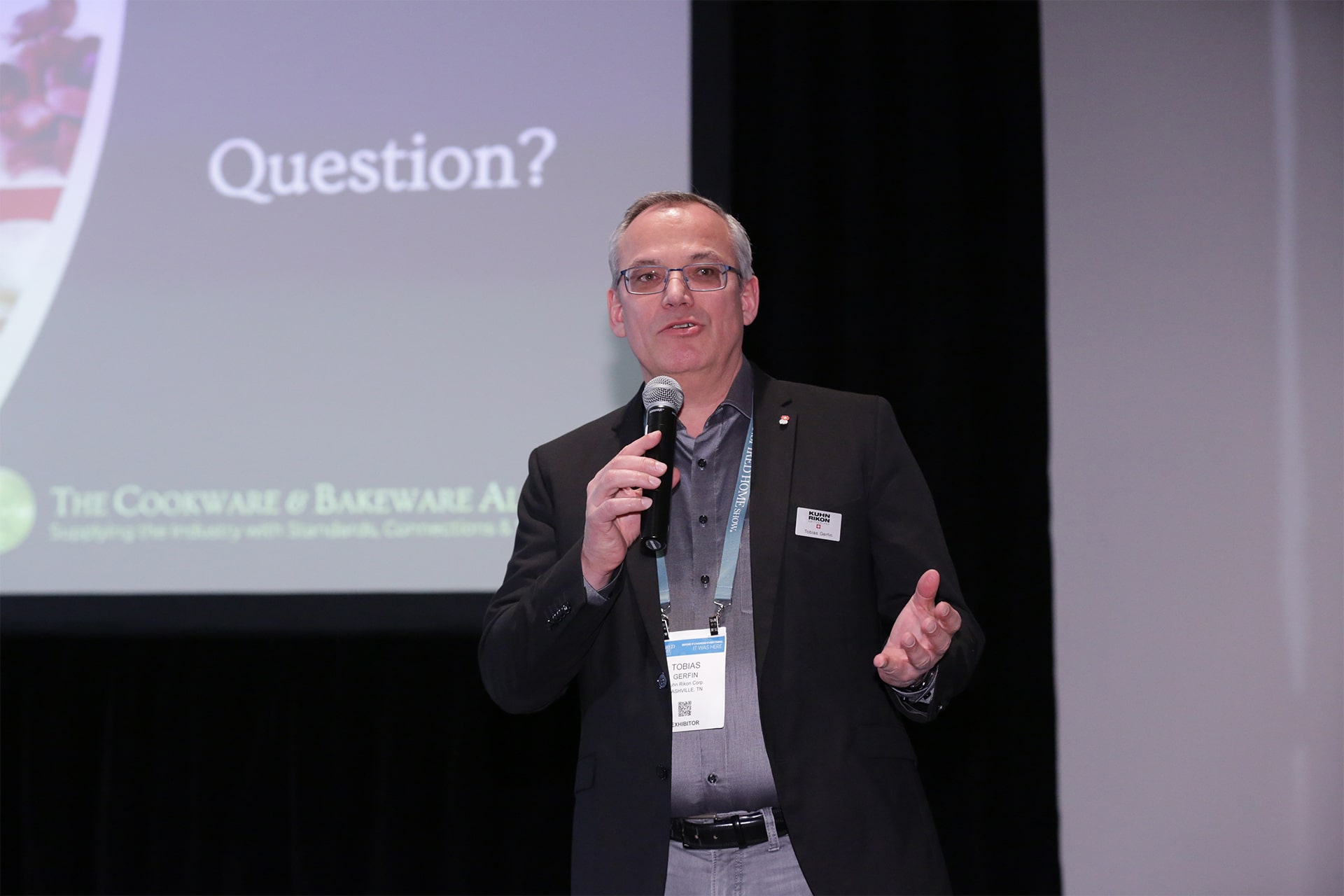Innovation Theater Sessions at The Inspired Home Show threw a spotlight on the important question of legislation involving PFAS.
In the session, PFAS Regulation and Housewares Update, Fran Groesbeck, managing director of the Cookware and Bakery Alliance and owner and founder of the Ten Touch Creative Agency, made the point that the ongoing efforts of the housewares industry to explore and take positions on the issue of PFAS legislation, whether the focal point is restriction or consumer information, isn’t about a single chemical or application. For the housewares industry, any product with added PFAS that contacts food is going to face potential regulation.
As European countries and individual states in the United States have prepared or pursued PFAS legislation, what became apparent is the range of products, from automotive to medical, that face regulation is broad. In the cookware realm, it’s not just about pots and pans, Groesbeck noted, but anything that is used to prepare, dispense or store foodstuffs and beverages.
A major challenge in dealing with PFAS is that there is no universal definition of what the acronym means and which of thousands of chemicals in the general class should fall under the PFAS definition. Then only 50 or 60 have been tested as to their effects on human beings. As such, science is catching up to activist claims and legislative actions.
Groesbeck said the Cookware and Bakeware Alliance and the related organizations working on the PFAS issue are asking legislators and regulators to look at the science in making their determinations about what might be toxic and what is not.
In terms of determining just what substances that are being scrutinized, Groesbeck said a certain general description can apply.
“PFAS is a group of chemicals that, when used, there is intention is to enhance or achieve a certain outcome with the betterment of that product and the situation in mind,” Groesbeck. “There are only roughly 600 of them in commerce. This large category of chemicals is not all the same. There are different groups and each group has different characteristics that further define them and the key risk factors, as well.”
Whatever group of PFAS chemicals is examined, she said, the three risk factors that require assessment are persistence, mobility and toxicity. But it’s a scale. The process of ranking those factors creates a very different risk profile, and it is something that the United States Environmental Protection Agency in the U.S. and the corresponding organizations elsewhere are trying to understand. The range of proposed legislation and regulations includes outright bans on one extreme and right-to-know requirements at the other end of the consideration.
“We support the right to know laws,” Groesbeck said. “This is along the lines of what cosmetics did. Consumers have the right to know. Consumers are asking for transparency.”
California and Colorado legislation, enacted as of January 1, are right-to-know laws. Other laws prohibit PFAS, as proposed in Maine, but, there, it evolved as more of a reporting requirement. However, the situation is dynamic not only as states that have enacted laws look at home to apply but also as other states try to formulate legislation, she said.
Tobias Gerfin (pictured above), CEO of Kuhn Rikon and president of the European Cookware Association, said the trouble with PFAS is that even the term itself is confusing because different organizations and governments define it in different ways.
“I studied physics and chemistry, and PFAS is an extremely complicated topic, with more than 10,000 substances,” he said. “And if you’re not a chemist you cannot really digest the material on the substances around. Mushrooms, there are about 14,000 mushrooms in the world, some of them are toxic, some of them are not. In Europe and in some states of the United States there is regulation on the way to ban all PFAS because they are persistent and supposedly toxic. Does anyone want to ban all mushrooms because there are a few that are toxic? And there is one big difference between the mushrooms and PFAS: I’m not aware and I’ve asked a lot of people who are even deeper into the topic do they know any substance within PFAS that is as toxic as some mushrooms, and they are not aware of any of this.”
Gerfin said it’s important to ban toxic substances, but, in Europe, the subject of PFAS is perceived as so complicated that legislators have become convinced that the best solution is to ban all chemicals in the class whether or not there is evidence of toxicity. He noted that the European proposals aren’t necessarily going to remain in their present form, and there will be a period of commentary when all the different industries that might be affected weigh in, so things may change. However, once final rulemaking is concluded and the process is finished, manufacturers will have 18 months to comply. So Gerfin said it’s important to understand how to comply with the regulations regarding cookware and other home goods products so that those companies affected are ready within that time frame.
Tom Lee, an attorney and partner with Bryan Cave Leighton Paisner said that a lot of uncertainty remains about how regulations will evolve because of the science, industry response and even where in the supply chain PFAS are present. Currently, proposed bans on PFAS have tended to shift to consumer information laws, and it is possible that other states will look to California and Colorado as they develop and pass laws that are more oriented toward consumer information. Uncertainty always remains, however. He noted that legislation from state to state isn’t necessarily consistent in terms of what chemicals are defined as PFAs. They aren’t even consistent in how they define products covered including cookware.
Lee added that a component of the laws that are frequently overlooked is related to marketing. Many of the laws and regulations proposed limit product claims related to PFAS. So, even if a company eliminates other PFAS chemicals, the presence of any other single chemical under the umbrella as it is defined by the rules makers, precludes the use of the term PFAS free, making the claim subject to litigation. Another consideration is how consumers have to be alerted. A link to a website with more information on the PFAS content may be required as may conspicuous product labeling.
It also should be noted that California legislation on children’s products, and the definition is broad, is going to add another layer of PFAS-related legislation that housewares companies may confront. Even packaging figures in, as PFAS chemicals are used in cardboard and paperboard products, among others. So, now, Lee says, is a good time to speak with both vendors and packaging suppliers to get into compliance with existing regulations and prepare for those coming down the pike.
In the end, the Cookware and Bakeware Alliance, the European Cookware Association and Bryan Cave Leighton Paisner are sources of information businesses may want to tap to keep current and address confusion on the subject of PFAS.
“Our hope is that you will turn to us,” Groesbeck said. “There’s a lot of information out there. There is also a lot of information that can cause panic and concern. We’re here to say if you have anything you need clarified, come to one of us. This is what we spend a lot of time living, breathing and studying. So, please, we’re here to help.” Zac Ludington, the head of global category growth for Amazon’s sustainable shopping program Climate Pledge Friendly detailed the program for Innovation Theater attendees interested in learning more about a program that rewards eco-friendly companies on the platform.





